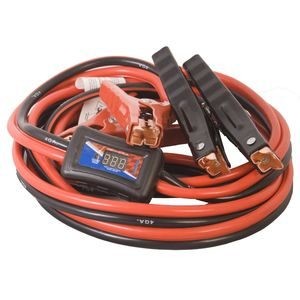Experiencing a dead car battery is a common yet frustrating situation for drivers. Whether it’s due to leaving the lights on, extreme weather, or simply an aging battery, finding yourself stranded with a vehicle that won’t start can be stressful. Knowing How To Jumpstart A Car By Yourself is an invaluable skill that empowers you to get back on the road quickly and safely. This guide provides a detailed, step-by-step approach to jump-starting your car when you’re alone, ensuring you can handle this situation with confidence.
Safety First: Essential Precautions Before You Begin
Before you even pop the hood, safety should be your absolute priority. Dealing with car batteries involves electricity and potentially corrosive substances, so taking the right precautions is crucial.
Always wear safety glasses and gloves when working around a car battery. Battery acid can cause serious burns, and sparks can ignite flammable gases. Having a battery acid neutralizer spray or a homemade solution of baking soda and water readily available is a smart move in case of accidental acid spills. It’s also wise to keep a fire extinguisher nearby as a further safety measure.
Carefully inspect your battery for any signs of damage. Bulging, cracks, or leaks are indicators of a compromised battery. In these situations, attempting to jumpstart the car is risky and should be avoided. Instead, battery replacement or calling for professional towing assistance is the safer course of action.
Step-by-Step Guide: Jump-Starting Your Car Using Jumper Cables Alone
While traditionally jump-starting a car requires another vehicle, it’s still possible to do it alone if you have a portable jump starter or, in some cases, by carefully using just jumper cables and your own car’s battery. However, for the purpose of this section, we will focus on the standard method using jumper cables, as the safety steps and principles remain similar across different methods.
Step 1: Accessing Your Car Battery and Terminals
The first step is to locate your car battery. In most vehicles, it’s situated under the hood. However, some car models might have the battery in less conventional locations, such as the trunk or even under the rear seat. If you’re unsure where your battery is, consult your car’s owner’s manual for the precise location. Additionally, some vehicles have designated jump-starting terminals under the hood, which are easier to access than the battery itself.
Step 2: Securely Connecting the Jumper Cables
Once you have located the battery or jump start terminals, follow these steps to connect the jumper cables safely and correctly:
- Ensure both your car and any assisting vehicle (if applicable, though for solo jump start we assume you are using your own car as the ‘donor’ by mistake, or using a portable jump starter later described) are completely turned off, including the ignition and all electrical accessories like headlights and radio.
- Identify the positive (+) and negative (-) terminals on both the dead battery and the good battery (or jump starter). They are usually marked with these symbols and are often color-coded (red for positive, black for negative).
- Attach one red positive clamp to the positive (+) terminal of the dead battery. Make sure you have a firm grip.
- Connect the other red positive clamp to the positive (+) terminal of the good battery source (another car’s battery or your portable jump starter).
- Now, take a black negative clamp and connect it to the negative (-) terminal of the good battery source.
- The final black negative clamp needs to be attached to a clean, unpainted metal part of your car’s engine block or chassis, away from the battery itself. This grounding step is crucial. Connecting to the chassis minimizes the risk of sparks near the battery, where flammable hydrogen gas can accumulate.
Step 3: Starting the Engine and Disconnecting Cables
With the jumper cables properly connected, proceed with starting your vehicle:
- Double-check all cable connections to ensure they are securely attached and will not come loose.
- If using another car, start the engine of the car with the good battery and let it run for a few minutes. This allows some charge to flow into the dead battery. If using a portable jump starter, turn it on as per the device’s instructions.
- Now, attempt to start the car with the dead battery. If it doesn’t start immediately, wait a few minutes and try again. Avoid cranking the engine for extended periods as this can damage the starter motor.
- Once the car starts, allow both vehicles to run (if using another car) or just your car to run (if using a jump starter) for another five to ten minutes. This will give the alternator a chance to begin recharging the battery.
- Carefully disconnect the jumper cables in the exact reverse order of connection to prevent sparks:
- Disconnect the black negative clamp from the engine block or chassis of the car that was just jump-started.
- Disconnect the black negative clamp from the negative terminal of the good battery source.
- Disconnect the red positive clamp from the positive terminal of the good battery source.
- Finally, disconnect the red positive clamp from the positive terminal of the now jump-started car’s battery.
Alternative Solo Jump-Start Methods: Portable Jump Starters and Battery Chargers
If you don’t have access to another vehicle, or prefer a more self-contained solution, portable jump starters and battery chargers offer excellent alternatives for jump-starting a car by yourself. Always refer to the manufacturer’s instructions for your specific device.
Utilizing a Portable Jump Starter
Portable jump starters are self-powered devices that eliminate the need for a second vehicle. They are compact, easy to store in your car, and can be a lifesaver in emergencies.
- Ensure your portable jump starter is charged.
- Connect the red clamp from the jump starter to the positive (+) terminal of your car battery.
- Connect the black clamp to a clean, unpainted metal surface under the hood, away from the battery.
- Turn on the jump starter according to its instructions.
- Start your car’s engine as you normally would.
Reviving Your Battery with a Battery Charger
Battery chargers are designed to slowly replenish the charge in a car battery. While not ideal for immediate jump-starting in an emergency, they can revive a deeply discharged battery over time.
- Turn off your car and locate the battery.
- Connect the red positive cable of the battery charger to the positive (+) terminal of your car battery.
- Attach the black negative cable to a metal part of the car’s chassis, not directly to the battery’s negative terminal.
- Plug in the battery charger to a power outlet and select the appropriate charging setting, typically a slow charge for deeply discharged batteries.
- Allow the battery to charge for the recommended duration, which could be several hours depending on the charger and battery condition.
- Once charged, disconnect the charger in reverse order and attempt to start your car.
Whether you choose jumper cables, a portable jump starter, or decide to maintain your battery health with a charger, AutoZone provides a wide range of automotive products to keep you prepared. Explore top brands like Duralast and rely on the expertise of their in-store associates for guidance.
Related Reading: Portable Jump Starter Vs Jumper Cables
FAQ: Jump-Starting Your Car Solo – Common Questions
Is it possible to jump-start my car if I’m completely alone?
Yes, absolutely. Portable jump starters and battery chargers are specifically designed for situations where you need to jump-start your car without another vehicle.
What safety gear is essential when jump-starting a car by myself?
Always wear safety gloves and goggles to protect yourself from battery acid and potential sparks. Keeping a battery acid neutralizer and a fire extinguisher nearby is also highly recommended.
Will a portable jump starter work for any type of car?
Portable jump starters come in various sizes and power capacities. Select a jump starter that is rated appropriately for your vehicle’s engine size to ensure it can deliver enough power to start your car.
Can a completely dead car battery be brought back to life without professional help?
In many cases, yes. A high-quality battery charger can often revive a completely dead battery. However, if the battery is old or damaged internally, it might not hold a charge, and replacement might be necessary. If you are unsure, consulting a professional mechanic is always a good idea.
Are there situations where jump-starting alone is not advisable?
If your car battery is in a difficult or dangerous location to access, or if the battery is visibly damaged (bulging, leaking, cracked), it’s best to seek professional assistance rather than attempting to jump-start it yourself.
Conclusion: Be Prepared and Stay Safe
Knowing how to jumpstart a car by yourself is a valuable skill for any driver. By understanding the steps, prioritizing safety, and considering alternative methods like portable jump starters, you can confidently handle a dead battery situation and get back on the road. Remember, regular car maintenance, including battery checks, can help prevent unexpected battery failures. Keeping jumper cables or a portable jump starter in your vehicle ensures you are always prepared for the unexpected.

